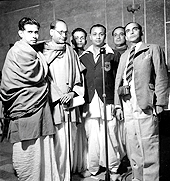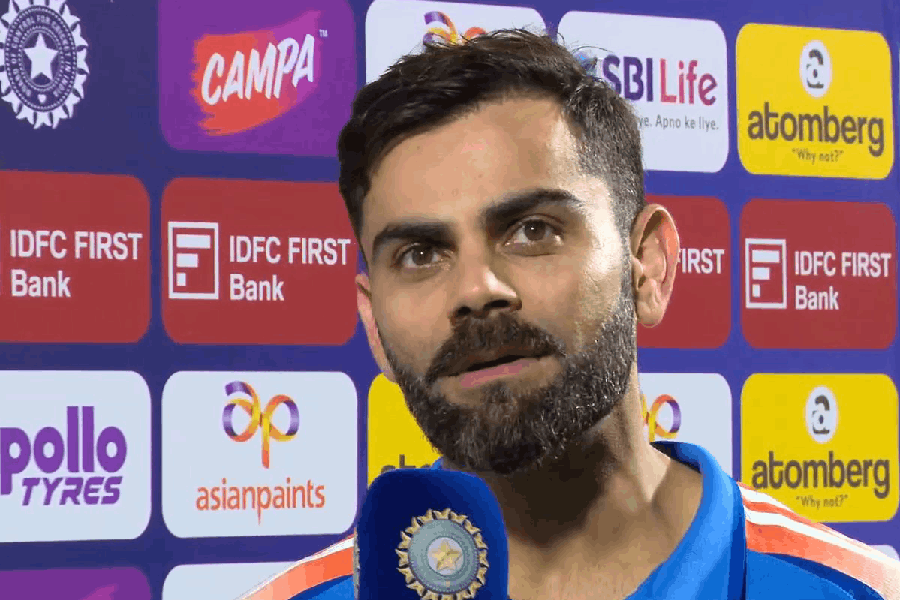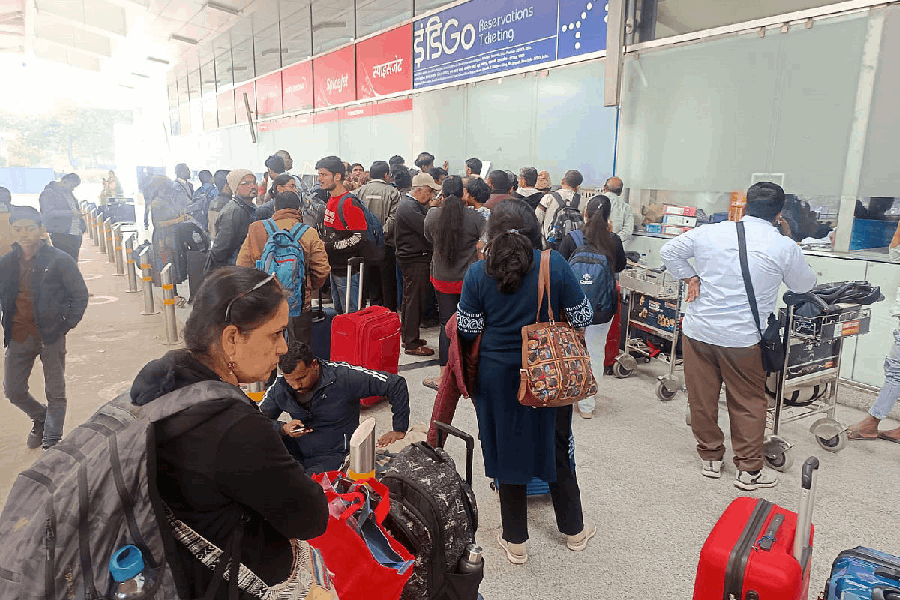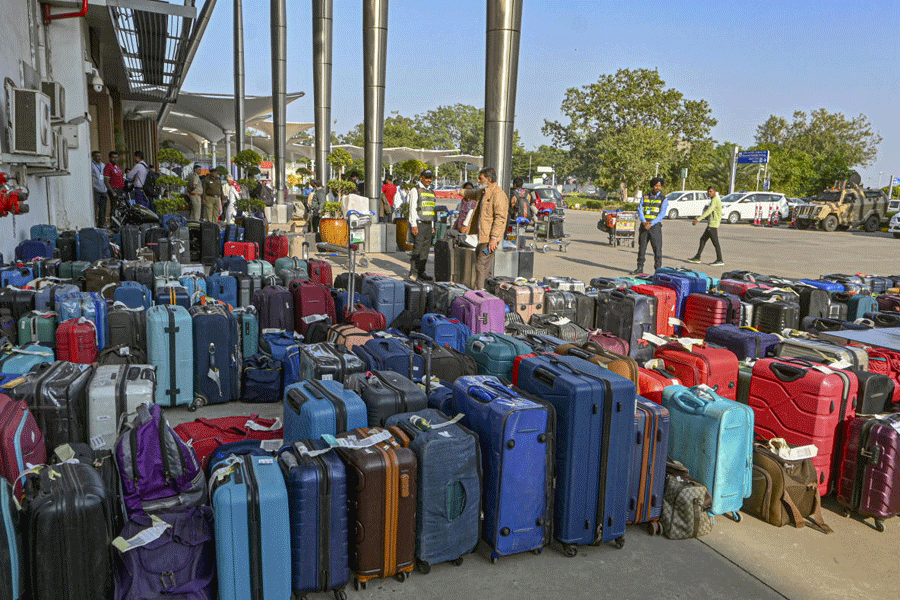 |
| PAST PERFECT: Birendra Krishna Bhadra (extreme left), Ahindra Chaudhuri (second from left), Jahar Ganguly (second from right), Durgadas Banerjee (extreme right) and others at a radio play. Picture by Parimal Goswami |
In the early 1940s, when electricity used to be supplied by Bihani & Company to a limited number of consumers in Malda town for about 12 hours after 6 pm, the radio, which was a great novelty, could be heard only after dark. But so popular were Galpa Dadur Asar and Sangeet Shikshar Asar, a music training programme conducted then by Pankaj Kumar Mallik, that the ladies of the small town had jointly petitioned the district magistrate to allow power to be supplied to their houses for some time on Sunday mornings. Equally heart-warming were the gripping hour-long plays that once used to hold paras in thrall on Friday evenings, and Anurodher Asar, a bouquet of Bengali songs.
The popularity of radio plays 40 years ago is comparable with TRPs of BR Chopra’s Mahabharat on Sunday afternoons in the late 1980s, or of KBC hosted by Amitabh Bachchan. AIR or All India Radio, established in 1936, has become part of national history and our collective memory.
 |
| A contemporary RJ hosting a programme at Akashvani Bhavan. Picture by Sayantan Ghosh |
Talk theatre artiste Jagannath Basu, who was for years associated with the Calcutta station of AIR, has another story that gives an indication of the one-time craze for radio plays. “For years, professional theatre shows at Hatibagan used to be held on Fridays, Saturdays and Sundays. But the Friday evening radio play became so popular that theatre shows were shifted to Thursdays.”
AIR lost its monopoly and primacy ever since it had to contend first with TV and then private FM channels. It is true that AIR, in spite of its occasionally didactic tone, is the only public service broadcaster that still airs educational and infotainment programmes aimed exclusively at women, students, industrial workers and the rural belt without losing much sleep over budgets, but owing to lack of professionalism, talent, new blood, innovative ideas and a certain ostrich-like attitude towards market realities, it is at the bottom of the heap today. The Calcutta station has a priceless archive of recordings but shows little sign of being aware of it.
 |
 |
 |
| (From top) The much-loved Indira Debi, who used to host Shishu Mahal; AIR artistes sit down for lunch at the radio station (Pictutres by Parimal Goswami); the old AIR building at 1 Garstin Place. (File picture) |
AIR owes its existence to amateur pioneers who formed radio clubs in the Indian metros. The privately owned Indian Broadcasting Company (IBC), set up on the lines of the BBC, started India’s first broadcasting studio and office in Apollo Bunder Road in Bombay and it went on air at 6pm on July 23, 1927.
The Calcutta station of the IBC initially opened at Temple Chambers opposite the high court, but then moved to 1 Garstin Place and started broadcasts from August 26, 1927. Programmes were labelled “European” and “Indian” and music and dialogue were broadcast every evening for three to four hours. The small building, which gradually turned into the city’s culture hub, was torn down in January 1997, but the Calcutta station had shifted long before on September 15, 1958, to its immense Eden Garden building.
According to H.R. Luthra’s book titled Indian Broadcasting, the Calcutta station’s first director was CC Wallick of the BBC and Nripendra Nath Majumdar was the producer of Indian programmes. Rai Chand Boral was one of Majumdar’s assistants. The other, Rajendra Nath Sen, was also half-back in Mohun Bagan Football Club.
Birendra Krishna Bhadra, who is synonymous with the evergreen Mahishasuramardini to be aired this year on September 27, was associated with AIR for several decades till he resigned as producer (drama). Pankaj Kumar Mallik sang his first song from the Calcutta station in 1927.
Lend me your ear
The blind singer Krishna Chandra De started his music lessons there in 1930, and it was continued famously by Pankaj Mallik. These names give us an inkling of the vast pool of talent — one would not know where to begin if one were to make a listing of the great musicians, actors, commentators, announcers and producers once associated with it — that the AIR, or Akashvani, had created over the years. Incidentally, the name Akashvani, it is said, was derived from the radio station of the same name owned by the princely state of Mysore.
Debabrata Mukherjee, who had joined Akashvani Siliguri in 1976 and is still known for his Monday morning programme Gaaner Bhelay devoted to Indian classical music, says he first went to the Garstin Place radio station in 1955 when Indira Debi, adored for her opening lines expressing her love and affection for her young listeners, used to be in charge of Shishu Mahal. When he joined AIR, Sudhir Sarkar used to conduct Palli Mangal for the rural audience with great aplomb. Accompanied by the fictitious characters Kashinath, Gobinda and Mangalmoy, they discussed farming problems, the sayings of the astrologer Khana, and injected humour and variety by introducing a comic character and taarja gaan (a folk music form) performances.
Some great musicians like Ustad Keramatullah Khan, Ustad Mohammad Sagiruddin Khan, Laddan Khan were employed here, and Jnan Prakash Ghosh and V.G. Jog were producers. Akhil Bharatiya Karyakram on Saturday nights and Radio Sangeet Sammelan brought together master musicians from all over the country. Among the announcers were elocutionists Partha Ghosh, Shankar Ghosh, Debasish Bose and Mihir Bandyopadhyay. Debabrata Mukherjee feels that “unless radio programmes have some aesthetic value they are not of much use. Programmes have become synthet
ic today because of excessive formalisation. There is hardly any freedom now.”
Jagannath Basu says at one time, apart from classics of Bengali literature, the best of world literature used to be turned into radio plays and thereby these reached even the unlettered. All the greats of theatre like Chhabi Biswas, Jahar Ganguly, Ahindra Choudhury, Sarajubala Debi, Sambhu Mitra, Ajitesh Bandyopadhyay and Basanta Choudhury performed here. The Calcutta station created many talk theatre artistes like Mita Chattopadhyay, who specialised in dialogues in dialects, and Anamika Saha, whose sensuous voice turned her into a successful romantic heroine on radio.
Bulbul Sarkar, who retired in 1984 as deputy chief producer, Western music, AIR, and whose conversations with Satyajit Ray on Beethoven and the auteur’s favourite music are still broadcast, recalls in her article My AIR days remembered the celebrated musicians from Benjamin Britten and Yehudi Menuhin to soprano Leontyne Price and pianist Rosalind Tureck, whose performances were often broadcast live when they performed in the city, and not infrequently at the AIR studio as well. Her reminiscences have appeared in Kolkata Betar edited by Bhabesh Das and Prabhat Kumar Das. Sarkar doesn’t know if her radio works any longer.
Others associated with AIR’s golden days recall anecdotes. Sobhan Pathak, who began his career as a sub-editor of Betar Jagat, a listing of radio programmes along with other articles, says Birendra Krishna Bhadra was once beaten up by hawkers when he tried to sell Betar Jagat in the Dalhousie area. Playwright Manoj Mitra has a story about Birendra Krishna too.
Mitra had produced many successful plays for the Calcutta station and recalls the devotion of men like Banikumar, who would read out each and every letter from the piles received every week. In his college days, Mitra had protested when Birendra Krishna had produced a play Mitra had penned after changing a couple of words. Birendra Krishna, always in a crumpled dhoti and snuff-stained chador, shot back saying if he could take liberties with Rabindranath and Saratchandra, he could certainly do the same with Mitra’s plays. At the same time he asked Mitra to take his pick of the books before him and turn it into a play.
Mitra says the AIR management now is not clear in its thinking on programmes.
Saoli Mitra has acted in umpteen radio plays from childhood but she complains that the AIR A channel transmission is so poor that sensitive voice modulations become warped. And Juthika Roy, whose songs were heard continuously from 1940 to 1980, says she cannot listen to Calcutta Station performances because singers have no sense of sur (tune) any longer, and tabla players are without any sense of loy (tempo).
Little wonder that if one takes into account Radio Audience Measurement or RAM, according to this week’s assessments, of the “total universe” of 85 lakh listeners in Calcutta, AIR FM Gold attracted a maximum of 12.5 lakh listeners, and AIR A a minimum 2.5 lakh listeners. Private FM channels are way ahead. But station director Pradip Kumar Mitra ignores RAM and depends instead on the AIR’s Audience Research Unit. According to its findings, the reachability of Aaaj Rate on FM Rainbow is 16 lakh, that of the Central news from Delhi on Calcutta A 14,87,107 in the morning, and of regional news that follows 10,37,062.
One reason for the drop in AIR’s reach is very poor transmission. Ranabir Datta, 55, a visually challenged listener and railway employee of Kharagpur, says the radio was an “eye-opener” for him but he is unable to tune in to Calcutta A programmes and Vividh Bharati, the commercial station.
Suchismita Roy, deputy director, engineering, AIR, admits that A, B and Vividh Bharati channels are more than 30 years old. Hence the inaudibility. They will be replaced in the next five-year plan with digital transmitters. But replacement of Vividh Bharati’s transmitter has not been approved yet.
The blind singer Krishna Chandra De started his music lessons there in 1930, and it was continued famously by Pankaj Mallik. These names give us an inkling of the vast pool of talent — one would not know where to begin if one were to make a listing of the great musicians, actors, commentators, announcers and producers once associated with it — that the AIR, or Akashvani, had created over the years. Incidentally, the name Akashvani, it is said, was derived from the radio station of the same name owned by the princely state of Mysore.
Debabrata Mukherjee, who had joined Akashvani Siliguri in 1976 and is still known for his Monday morning programme Gaaner Bhelay devoted to Indian classical music, says he first went to the Garstin Place radio station in 1955 when Indira Debi, adored for her opening lines expressing her love and affection for her young listeners, used to be in charge of Shishu Mahal. When he joined AIR, Sudhir Sarkar used to conduct Palli Mangal for the rural audience with great aplomb. Accompanied by the fictitious characters Kashinath, Gobinda and Mangalmoy, they discussed farming problems, the sayings of the astrologer Khana, and injected humour and variety by introducing a comic character and taarja gaan (a folk music form) performances.
Some great musicians like Ustad Keramatullah Khan, Ustad Mohammad Sagiruddin Khan, Laddan Khan were employed here, and Jnan Prakash Ghosh and V.G. Jog were producers. Akhil Bharatiya Karyakram on Saturday nights and Radio Sangeet Sammelan brought together master musicians from all over the country. Among the announcers were elocutionists Partha Ghosh, Shankar Ghosh, Debasish Bose and Mihir Bandyopadhyay. Debabrata Mukherjee feels that “unless radio programmes have some aesthetic value they are not of much use. Programmes have become synthetic today because of excessive formalisation. There is hardly any freedom now.”
Jagannath Basu says at one time, apart from classics of Bengali literature, the best of world literature used to be turned into radio plays and thereby these reached even the unlettered. All the greats of theatre like Chhabi Biswas, Jahar Ganguly, Ahindra Choudhury, Sarajubala Debi, Sambhu Mitra, Ajitesh Bandyopadhyay and Basanta Choudhury performed here. The Calcutta station created many talk theatre artistes like Mita Chattopadhyay, who specialised in dialogues in dialects, and Anamika Saha, whose sensuous voice turned her into a successful romantic heroine on radio.
Bulbul Sarkar, who retired in 1984 as deputy chief producer, Western music, AIR, and whose conversations with Satyajit Ray on Beethoven and the auteur’s favourite music are still broadcast, recalls in her article My AIR days remembered the celebrated musicians from Benjamin Britten and Yehudi Menuhin to soprano Leontyne Price and pianist Rosalind Tureck, whose performances were often broadcast live when they performed in the city, and not infrequently at the AIR studio as well. Her reminiscences have appeared in Kolkata Betar edited by Bhabesh Das and Prabhat Kumar Das. Sarkar doesn’t know if her radio works any longer.
Others associated with AIR’s golden days recall anecdotes. Sobhan Pathak, who began his career as a sub-editor of Betar Jagat, a listing of radio programmes along with other articles, says Birendra Krishna Bhadra was once beaten up by hawkers when he tried to sell Betar Jagat in the Dalhousie area. Playwright Manoj Mitra has a story about Birendra Krishna too.
Mitra had produced many successful plays for the Calcutta station and recalls the devotion of men like Banikumar, who would read out each and every letter from the piles received every week. In his college days, Mitra had protested when Birendra Krishna had produced a play Mitra had penned after changing a couple of words. Birendra Krishna, always in a crumpled dhoti and snuff-stained chador, shot back saying if he could take liberties with Rabindranath and Saratchandra, he could certainly do the same with Mitra’s plays. At the same time he asked Mitra to take his pick of the books before him and turn it into a play.
Mitra says the AIR management now is not clear in its thinking on programmes.
Saoli Mitra has acted in umpteen radio plays from childhood but she complains that the AIR A channel transmission is so poor that sensitive voice modulations become warped. And Juthika Roy, whose songs were heard continuously from 1940 to 1980, says she cannot listen to Calcutta Station performances because singers have no sense of sur (tune) any longer, and tabla players are without any sense of loy (tempo).
Little wonder that if one takes into account Radio Audience Measurement or RAM, according to this week’s assessments, of the “total universe” of 85 lakh listeners in Calcutta, AIR FM Gold attracted a maximum of 12.5 lakh listeners, and AIR A a minimum 2.5 lakh listeners. Private FM channels are way ahead. But station director Pradip Kumar Mitra ignores RAM and depends instead on the AIR’s Audience Research Unit. According to its findings, the reachability of Aaaj Rate on FM Rainbow is 16 lakh, that of the Central news from Delhi on Calcutta A 14,87,107 in the morning, and of regional news that follows 10,37,062.
One reason for the drop in AIR’s reach is very poor transmission. Ranabir Datta, 55, a visually challenged listener and railway employee of Kharagpur, says the radio was an “eye-opener” for him but he is unable to tune in to Calcutta A programmes and Vividh Bharati, the commercial station.
Suchismita Roy, deputy director, engineering, AIR, admits that A, B and Vividh Bharati channels are more than 30 years old. Hence the inaudibility. They will be replaced in the next five-year plan with digital transmitters. But replacement of Vividh Bharati’s transmitter has not been approved yet.










